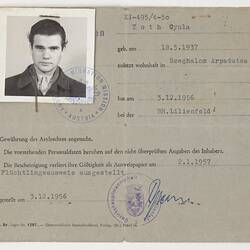Summary
Note: This image depicts people wearing 'black face' and cultural stereotypical costumes. Such activities are not condoned by Museums Victoria which considers them to be racist. Historical distance and context do not excuse or erase this fact.
Black and white digital photograph of Stephen Schmideg (far right) and three of his neighbourhood friends on May Day in Szekesfehervar, Hungary in1946. The children are in various local costumes and Stephen is wearing 'black face'. It was taken in Szekesfehervar where they moved in 1949, having had their business and home in Gyor confiscated. The couple migrated to Australia with their sons Stephen and Peter from Hungary in January 1957.
Stephen and Peter Schmideg fled Budapest with their parents Zoltan and Margit after the Soviet repression of the Hungarian revolution in 1956. Zoltan and Margit had already survived appalling experiences and loss of family as Jews during World War II. They managed to escape to Austria, before being processed and joining their ship the Aurelia in Genoa, before finally arriving in Melbourne on 28 January 1957.
Description of Content
Four children wearing costume standing in a line outdoors.
Physical Description
Black and white digital photograph.
Significance
Statement of Historical Significance:
This collection of objects and photographs provides a rare opportunity to document the experiences of migrant children, both at point of arrival in Australia and subsequent settlement. The toys represent the interweaving of both Australian and American popular culture in the 1950s, on the cusp of the launch of television in Australia, as well as the increasing popularity of Australian native symbols to represent an Australian identity. The photos of the children at play with the items is a rare opportunity to document the objects in use at the time. They also demonstrate the role of some community groups (in this case Jewish) in greeting newly arrived migrants and the recognition of the special attention children might require, particularly after traumatic experiences in countries of origin.
More Information
-
Collecting Areas
Migration & Cultural Diversity, Childhood, Images & Image Making, Leisure
-
Person Depicted
-
Format
Digital file, Black & White
-
Classification
-
Category
-
Discipline
-
Type of item
-
Keywords
Hungarian Immigration, Hungarian Communities, Children, Childhood, Identifications, Photography, Cultural Stereotypes, Racism


